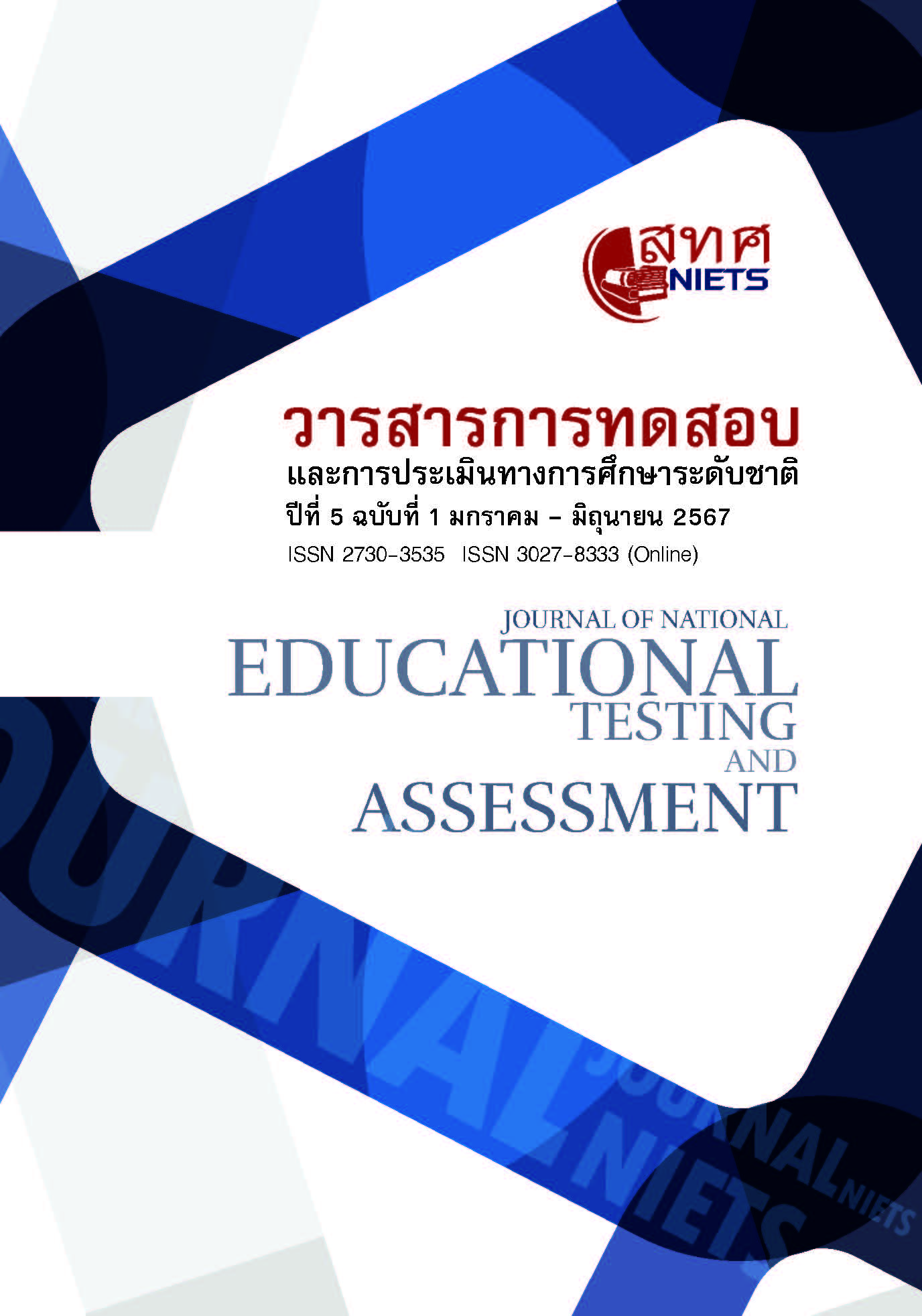แนวทางการวัดและประเมินความฉลาดรู้ด้านสถิติในระดับชั้นมัธยมศึกษา
Main Article Content
บทคัดย่อ
ความฉลาดรู้ด้านสถิติเป็นทักษะสำคัญสำหรับพลเมืองในยุคที่ขับเคลื่อนด้วยข้อมูลข่าวสาร เป้าหมายปลายทางคือการรู้เท่าทันข้อสรุปทางสถิติที่พบในบริบทส่วนตัวและส่วนรวม เนื่องด้วยมีองค์ประกอบที่สำคัญ ได้แก่ ความรู้ทางสถิติ บริบท และคณิตศาสตร์ ทำให้การวัดและประเมินความฉลาดรู้ด้านสถิติมีแนวคิดต่างออกไปจากการตรวจสอบเพียงว่าถูกหรือผิด บทความนี้มีวัตถุประสงค์เพื่อนำเสนอแนวคิดสำหรับการวัดและการประเมินความฉลาดรู้ด้านสถิติ สาระสำคัญของบทความประกอบด้วย 1) ความฉลาดรู้ด้านสถิติเป็นความสามารถในการตีความ การประเมินข้อสรุปทางสถิติอย่างมีวิจารณญาณ และการอภิปรายหรือสื่อสารความคิดเห็นของตนเองเพื่อโต้แย้งหรือสนับสนุนข้อสรุปทางสถิติ และนำไปสู่การตัดสินใจเกี่ยวกับเรื่องส่วนตัวและส่วนรวม 2) การวัดและประเมินความฉลาดรู้ด้านสถิติสำหรับนักเรียน พิจารณาจากความสามารถที่เป็นโครงสร้าง 3 ลำดับชั้น ได้แก่ ความเข้าใจคำศัพท์พื้นฐานทางสถิติ ความเข้าใจคำศัพท์ทางสถิติเมื่อปรากฏในบริบท และความสามารถในการตั้งคำถามหรือข้อสงสัยบนแนวคิดที่ซับซ้อนหรือปราศจากการให้เหตุผลทางสถิติเพื่อนำไปสู่ความเข้าใจหรือโต้แย้งข้อสรุป นิยมจำแนกระดับความฉลาดรู้ด้านสถิติเป็น 6 ระดับ จากระดับล่างสุดไปสู่ระดับสูงสุด ได้แก่ ระดับขีดจำกัด ระดับไม่เป็นทางการ ระดับไม่สอดคล้องกัน ระดับสอดคล้องแต่ปราศจากวิจารณญาณ ระดับมีวิจารณญาณ และระดับมีวิจารณญาณทางคณิตศาสตร์ และ 3) การใช้ข้อสอบจำแนกระดับความฉลาดรู้ด้านสถิติทั้ง 6 ระดับ กับนักเรียนชั้นมัธยมศึกษาปีที่ 3 จำนวน 35 คน และชั้นมัธยมศึกษาปีที่ 6 จำนวน 28 คน รวม 63 คน พบว่าสามารถเลือกใช้ข้อสอบที่สอดคล้องกับลักษณะข้อสอบที่ใช้ส่งเสริมในระดับมีวิจารณญาณทางคณิตศาสตร์ จากนั้นสร้างเกณฑ์การพิจารณาโดยอาศัยพฤติกรรมบ่งชี้ของความฉลาดรู้ด้านสถิติแต่ละระดับ
Article Details

อนุญาตภายใต้เงื่อนไข Creative Commons Attribution-NonCommercial-NoDerivatives 4.0 International License.
under process
เอกสารอ้างอิง
สถาบันส่งเสริมการสอนวิทยาศาสตร์และเทคโนโลยี. (2560). คู่มือการใช้หลักสูตรกลุ่มสาระการเรียนรู้คณิตศาสตร์ (ฉบับปรับปรุง พ.ศ. 2560) ตามหลักสูตรแกนกลางการศึกษาขั้นพื้นฐานพุทธศักราช 2551 ระดับมัธยมศึกษาตอนต้น. กรุงเทพฯ: สถาบันส่งเสริมการสอนวิทยาศาสตร์ และเทคโนโลยี.
สำนักงานคณะกรรมการการศึกษาขั้นพื้นฐาน. (2560). ตัวชี้วัดและสาระการเรียนรู้แกนกลาง กลุ่มสาระการเรียนรู้คณิตศาสตร์ (ฉบับปรับปรุง พ.ศ. 2560) ตามหลักสูตรแกนกลางการศึกษาขั้นพื้นฐานพุทธศักราช 2551. กรุงเทพฯ: โรงพิมพ์ชุมนุมสหกรณ์การเกษตรแห่งประเทศไทย.
Aziz, A.M., & Rosli, R. (2021). A Systematic Literature Review on Developing Students' Statistical Literacy Skills. Journal of Physics: Conference Series, 1806 (2021), 1-7.
Bakker, A., Cai, J., & Zenger, L. (2021). Future Themes of Mathematics Education Research: An International Survey Before and During the Pandemic. Educational Studies in Mathematics, 107, 1-24.
Bargagliotti, A., Franklin, C., Arnold, P., Gould, R., Johnson, S., Perez, L., & Spangler, D.A. (2020). Pre-K–12 Guidelines for Assessment and Instruction in Statistics Education II (GAISE II). Alexandria, VA: American Statistical Association.
Batanero, C., Estepa, A., Godino, J.D., & Green, D.R. (1996). Intuitive Strategies and Preconceptions About Association in Contingency Tables. Journal for Research in Mathematics Education, 27 (2), 151-169.
Ben-Zvi, D., & Garfield, J. (2004). The Challenge of Developing Statistical Literacy, Reasoning and Thinking. New York: Kluwer Academic.
Büscher, C. (2022). Design Principle for Developing Statistical Literacy in Middle Schools. Statistics Education Research Journal, 21 (1), 1-16.
Callingham, R., & Watson, J. (2017). The Development of Statistical Literacy at School. Statistics Education Research Journal, 16 (1), 181-201.
Gal. I. (2002). Adults' Statistical literacy: Meanings, Components, Responsibilities. International Statistical Review, 70 (1), 1-25.
Kaplan, J.J., & Thorpe, J. (2010). Post Secondary and Adult Statistical Literacy: Assessing Beyond the Classroom. In C. Reading (Ed.), Data and Context in Statistics Education: Towards an Evidence-Based Society. Proceedings of the Eighth International Conference on Teaching Statistics (ICOTS8, July, 2010), Ljubljana, Slovenia. Voorburg, The Netherlands: International Statistical Institute. www.stat.auckland.ac. nz/~iase/publications.php
Kurnia, A.B., Lowrie, T., & Patahuddin, S.M. (2023). The Development of High School Students’ Statistical Literacy Across Grade Level. Mathematics Education Research Journal. https://doi.org/10.1007/s13394-023-00449-x
Schield, M. (2004). Information Literacy, Statistical Literacy and Data Literacy. Retrieved from https://iassistquarterly.com/public/pdfs/iqvol282_3shields.pdf
Sharma, S. (2017). Definitions and Models of Statistical Literacy: A Literature Review. Open Review of Educational Research, 4 (1), 118-133.
Wallman, K.K. (1993). Enhancing Statistical Literacy: Enriching Society. Journal of the American Statistical Association, 88 (421), 1-8.
Watson, J., & Callingham, R. (2003). Statistical Literacy: A Complex Hierarchical Construct. Statistics Education Research Journal, 2 (2), 3-46.


